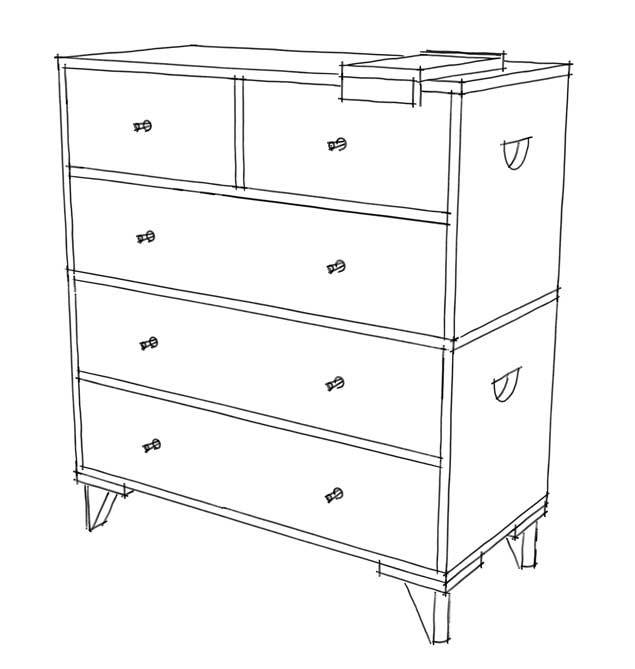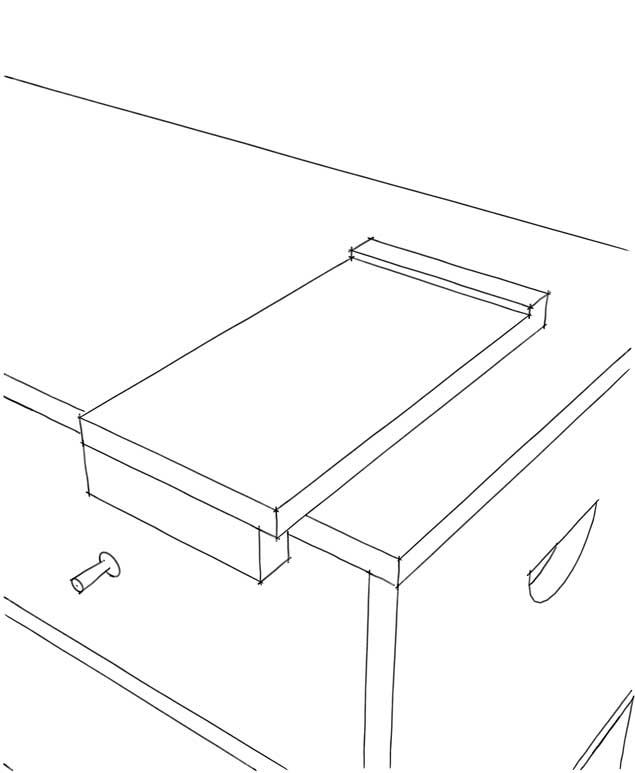We may receive a commission when you use our affiliate links. However, this does not impact our recommendations.
 Building furniture without a dedicated workshop or even a workbench has always been a challenge. While there are lots of ways to get around the problem, one of my favorites is what is called the “bureau-shop.”
Building furniture without a dedicated workshop or even a workbench has always been a challenge. While there are lots of ways to get around the problem, one of my favorites is what is called the “bureau-shop.”
This is where you transform an old chest of drawers into a complete hand-tool shop for light work. The top of the bureau is used as the benchtop (more on that in a minute). The top drawers store tools, while the bottom drawers hold the wood, the assemblies you are working on and even the shavings and the sawdust from the work.
As a result, you have the ability to work inside the house without disrupting the look of a guest bedroom or office.
I first discovered the “bureau-shop” when reading a charming series of four books from 1864 titled “John Gay; or Work for Boys” (Hurd & Houghton) by Jacob Abbott. The books follows the adventures of young John Gay and his efforts to become a woodworker.
You can download the short chapter on the bureau-shop here.
What is fascinating to me is how the author took great pains to describe how to work on the top of the bureau without scarring it. Planing and sawing is done with a bench hook. Sawing large pieces of work is handled by sawing it on a sitting bench, with all the waste falling into the lower drawer.
 The book doesn’t address how to cut tenons, mortises or dovetails. Most of John Gay’s projects are nailed together. But I’m sure you could manage by clamping the workpieces to the bureau. I also tried to think of a way to use the top drawer as a vise, but it was getting too complicated.
The book doesn’t address how to cut tenons, mortises or dovetails. Most of John Gay’s projects are nailed together. But I’m sure you could manage by clamping the workpieces to the bureau. I also tried to think of a way to use the top drawer as a vise, but it was getting too complicated.
Anyway, if you are struggling with becoming a woodworker without a bench or a shop, take a lesson from a fictional boy – there are lots of ways around the problem.
— Christopher Schwarz
Here are some supplies and tools we find essential in our everyday work around the shop. We may receive a commission from sales referred by our links; however, we have carefully selected these products for their usefulness and quality.










Yoav Liberman’s ‘bench bull’ would be a versatile addition for workholding, including dovetails and mortises.
https://www.popularwoodworking.com/woodworking-blogs/editors-blog/bench-bull-the-jack-of-all-bench-jigs-part-1
https://www.popularwoodworking.com/woodworking-blogs/editors-blog/bench-bull-the-jack-of-all-bench-jigs-part-2
https://www.popularwoodworking.com/woodworking-blogs/editors-blog/bench-bull-the-jack-of-all-bench-jigs-part-3
https://www.popularwoodworking.com/woodworking-blogs/editors-blog/bench-bulls-by-blog-readersvery-cool-designs
Excellent suggestion for the newly interested. Unfortunately John Gay’s book is a romantic throw away. Mother is never going to be talked out of a marble top 4 drawer dresser. Further, four drawers are too high. Go to the junk shop and buy a three drawer dresser with a wooden top about 34″ tall. May need some bracing. You could even add a top of face glued 2 x 4s and a yellow pine facing around the pine top. Too high now? Shorten the feet.I need not go farther. Just think of all the clamps, devices and dinguses you can install. Wow!
I think you’re looking at this all backwards. Just throw the Bureau away, move in a bench to use as a bureau (when necessary), and problem solved. Simply a matter of priiority’s. You’re either a Woodworker, or Fancy Nancy.
For a vise drawer, put a stop in the bottom of the drawer the thickness of the wood you’re working on, close the drawer with the work sticking out of the top and throw a clamp on the drawer and synch it down to the back of the cabinet. Could be adapted to both end and side grain. If dovetailing, and the piece is too long to work out of the top drawer, set up a lower drawer with the same rig so the work is at a comfy height.
I wish I could post a pic of a sketch of what I’m thinking, my though does not transfer well to text.
I’ve used an old kitchen cupboard in my small shed for a long time. I glued two worktop slabs together, fitted a small vice, drilled a hole for a bench hook, glued and screwed to the cupboard top. Bingo. Any serious woodcutting takes place on two of Chris’s knee high saw benches. If you make one two inches wider than the other they nest. It’s a sort of minimalist arrangement for a small city centre house.
By the way John Gay wrote the Beggar’s Opera. Busy and long lived guy.
brilliant, absolutely genius. I’ve been thinking about how to bring some work into the house during the cold months, and this is just the ticket. thanks for discovering this!
What a wonderful little tome!
I went onto Google books to read a little further “John Gay, Or Work for Boys” only to find words I had to look-up to ensure I was not taking them out of context!
What a beautiful word: Quoin or Quoining and sagacious used in 1864, I am guessing with the intent that either the reader had this in his vocabulary or would look it up to further his understanding or simply increase his vocabulary! (Learning through “play?)
Hmmmm Chris. You have me thinking. I have been given permission to put another workbench into a spare bedroom. I had figured I would make one. Since it was an inside bench with rough work being done outside, I didn’t need a huge one.
Now you put this idea into my head. Could be fun. Curse you and thank you. If I’m not careful I will become one of your undecided folks.